Prostate MRI, with or without MRI-targeted biopsy, and systematic biopsy for detecting prostate cancer
- PMID: 31022301
- PMCID: PMC6483565
- DOI: 10.1002/14651858.CD012663.pub2
Prostate MRI, with or without MRI-targeted biopsy, and systematic biopsy for detecting prostate cancer
Abstract
Background: Multiparametric magnetic resonance imaging (MRI), with or without MRI-targeted biopsy, is an alternative test to systematic transrectal ultrasonography-guided biopsy in men suspected of having prostate cancer. At present, evidence on which test to use is insufficient to inform detailed evidence-based decision-making.
Objectives: To determine the diagnostic accuracy of the index tests MRI only, MRI-targeted biopsy, the MRI pathway (MRI with or without MRI-targeted biopsy) and systematic biopsy as compared to template-guided biopsy as the reference standard in detecting clinically significant prostate cancer as the target condition, defined as International Society of Urological Pathology (ISUP) grade 2 or higher. Secondary target conditions were the detection of grade 1 and grade 3 or higher-grade prostate cancer, and a potential change in the number of biopsy procedures.
Search methods: We performed a comprehensive systematic literature search up to 31 July 2018. We searched CENTRAL, MEDLINE, Embase, eight other databases and one trials register.
Selection criteria: We considered for inclusion any cross-sectional study if it investigated one or more index tests verified by the reference standard, or if it investigated the agreement between the MRI pathway and systematic biopsy, both performed in the same men. We included only studies on men who were biopsy naïve or who previously had a negative biopsy (or a mix of both). Studies involving MRI had to report on both MRI-positive and MRI-negative men. All studies had to report on the primary target condition.
Data collection and analysis: Two reviewers independently extracted data and assessed the risk of bias using the QUADAS-2 tool. To estimate test accuracy, we calculated sensitivity and specificity using the bivariate model. To estimate agreement between the MRI pathway and systematic biopsy, we synthesised detection ratios by performing random-effects meta-analyses. To estimate the proportions of participants with prostate cancer detected by only one of the index tests, we used random-effects multinomial or binary logistic regression models. For the main comparisions, we assessed the certainty of evidence using GRADE.
Main results: The test accuracy analyses included 18 studies overall.MRI compared to template-guided biopsy: Based on a pooled sensitivity of 0.91 (95% confidence interval (CI): 0.83 to 0.95; 12 studies; low certainty of evidence) and a pooled specificity of 0.37 (95% CI: 0.29 to 0.46; 12 studies; low certainty of evidence) using a baseline prevalence of 30%, MRI may result in 273 (95% CI: 249 to 285) true positives, 441 false positives (95% CI: 378 to 497), 259 true negatives (95% CI: 203 to 322) and 27 (95% CI: 15 to 51) false negatives per 1000 men. We downgraded the certainty of evidence for study limitations and inconsistency.MRI-targeted biopsy compared to template-guided biopsy: Based on a pooled sensitivity of 0.80 (95% CI: 0.69 to 0.87; 8 studies; low certainty of evidence) and a pooled specificity of 0.94 (95% CI: 0.90 to 0.97; 8 studies; low certainty of evidence) using a baseline prevalence of 30%, MRI-targeted biopsy may result in 240 (95% CI: 207 to 261) true positives, 42 (95% CI: 21 to 70) false positives, 658 (95% CI: 630 to 679) true negatives and 60 (95% CI: 39 to 93) false negatives per 1000 men. We downgraded the certainty of evidence for study limitations and inconsistency.The MRI pathway compared to template-guided biopsy: Based on a pooled sensitivity of 0.72 (95% CI: 0.60 to 0.82; 8 studies; low certainty of evidence) and a pooled specificity of 0.96 (95% CI: 0.94 to 0.98; 8 studies; low certainty of evidence) using a baseline prevalence of 30%, the MRI pathway may result in 216 (95% CI: 180 to 246) true positives, 28 (95% CI: 14 to 42) false positives, 672 (95% CI: 658 to 686) true negatives and 84 (95% CI: 54 to 120) false negatives per 1000 men. We downgraded the certainty of evidence for study limitations, inconsistency and imprecision.Systemic biopsy compared to template-guided biopsy: Based on a pooled sensitivity of 0.63 (95% CI: 0.19 to 0.93; 4 studies; low certainty of evidence) and a pooled specificity of 1.00 (95% CI: 0.91 to 1.00; 4 studies; low certainty of evidence) using a baseline prevalence of 30%, systematic biopsy may result in 189 (95% CI: 57 to 279) true positives, 0 (95% CI: 0 to 63) false positives, 700 (95% CI: 637 to 700) true negatives and 111 (95% CI: 21 to 243) false negatives per 1000 men. We downgraded the certainty of evidence for study limitations and inconsistency.Agreement analyses: In a mixed population of both biopsy-naïve and prior-negative biopsy men comparing the MRI pathway to systematic biopsy, we found a pooled detection ratio of 1.12 (95% CI: 1.02 to 1.23; 25 studies). We found pooled detection ratios of 1.44 (95% CI 1.19 to 1.75; 10 studies) in prior-negative biopsy men and 1.05 (95% CI: 0.95 to 1.16; 20 studies) in biopsy-naïve men.
Authors' conclusions: Among the diagnostic strategies considered, the MRI pathway has the most favourable diagnostic accuracy in clinically significant prostate cancer detection. Compared to systematic biopsy, it increases the number of significant cancer detected while reducing the number of insignificant cancer diagnosed. The certainty in our findings was reduced by study limitations, specifically issues surrounding selection bias, as well as inconsistency. Based on these findings, further improvement of prostate cancer diagnostic pathways should be pursued.
Conflict of interest statement
Frank‐Jan H Drost: none known
Daniel F Osses: none known
Daan Nieboer: none known
Ewout W Steyerberg reports the following relevant financial activities outside the submitted work: receives royalties from Springer for the textbook entitled
Chris H Bangma: none known
Monique J Roobol: none known
Ivo G Schoots reports the following relevant activities related to the submitted work: a guideline associate panel member of the EAU–ESTRO–ESUR–SIOG Guidelines on Prostate Cancer
Figures
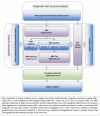

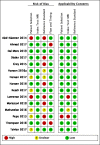
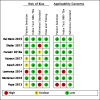
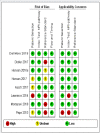


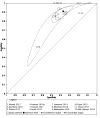
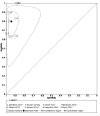
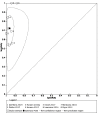

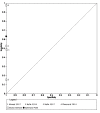


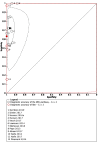
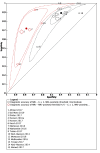
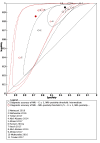
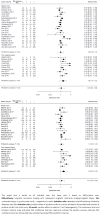
































































Comment in
-
Editorial Comment.J Urol. 2020 Jul;204(1):32. doi: 10.1097/JU.0000000000000757.01. Epub 2020 Apr 7. J Urol. 2020. PMID: 32255755 No abstract available.
-
Editorial Comment.J Urol. 2020 Jul;204(1):32. doi: 10.1097/JU.0000000000000757.02. Epub 2020 Apr 7. J Urol. 2020. PMID: 32255756 No abstract available.
References
References to studies included in this review
Abd‐Alazeez 2014 {published and unpublished data}
Ahmed 2017 {published and unpublished data}
-
- Ahmed HU, El‐Shater Bosaily A, Brown LC, Gabe R, Kaplan R, Parmar MK, et al. Diagnostic accuracy of multi‐parametric MRI and TRUS biopsy in prostate cancer (PROMIS): a paired validating confirmatory study. Lancet 2017;389(10071):815‐22. - PubMed
Alberts 2017 {published data only}
-
- Alberts AR, Schoots IG, Bokhorst LP, Drost FH, Leenders GJ, Krestin GP, et al. Characteristics of prostate cancer found at fifth screening in the European Randomized Study of Screening for Prostate Cancer Rotterdam: can we selectively detect high‐grade prostate cancer with upfront multivariable risk stratification and magnetic resonance imaging?. European Urology 19 June 2017 [Epub ahead of print];S0302‐2838(17):30514‐6. - PubMed
Boesen 2017a {published data only (unpublished sought but not used)}
-
- Boesen L, Nørgaard N, Løgager V, Balslev I, Thomsen HS. A prospective comparison of selective multiparametric magnetic resonance imaging fusion‐targeted and systematic transrectal ultrasound‐guided biopsies for detecting prostate cancer in men undergoing repeated biopsies. Urologia Internationalis 2017;99(4):384‐91. - PubMed
Boesen 2018 {published and unpublished data}
-
- Boesen L, Nørgaard N, Løgager V, Balslev I, Bisbjerg R, Thestrup K‐C, Winther, et al. Assessment of the diagnostic accuracy of biparametric magnetic resonance imaging for prostate cancer in biopsy‐naïve men the Biparametric MRI for Detection of Prostate Cancer (BIDOC) Study. JAMA Network Open 2018;1(2):e180219. - PMC - PubMed
Castellucci 2017 {published and unpublished data}
-
- Castellucci R, Linares Quevedo AI, Sánchez Gómez FJ, Díez Rodríguez J, Cogorno L, Cogollos Acuña I, et al. Prospective nonrandomized study of diagnostic accuracy comparing prostate cancer detection by transrectal ultrasound‐guided biopsy to magnetic resonance imaging with subsequent MRI‐guided biopsy in biopsy‐naïve patients. Minerva Urologica e Nefrologica 2017;69(6):589‐95. - PubMed
Chang 2017 {published and unpublished data}
-
- Chang CH, Chiu HC, Lin WC, Ho TL, Chang H, Chang YH, et al. The influence of serum prostate‐specific antigen on the accuracy of magnetic resonance imaging targeted biopsy versus saturation biopsy in patients with previous negative biopsy. BioMed Research International 2017;2017:7617148. - PMC - PubMed
Chen 2015 {published data only}
Cool 2016 {published data only}
-
- Cool DW, Romagnoli C, Izawa JI, Chin J, Gardi L, Tessier D, et al. Comparison of prostate MRI‐3D transrectal ultrasound fusion biopsy for first‐time and repeat biopsy patients with previous atypical small acinar proliferation. Canadian Urological Association Journal 2016;10(9‐10):342‐8. - PMC - PubMed
Costa 2013 {published data only}
Dal Moro 2019 {published and unpublished data}
-
- Dal Moro F, Zecchini G, Morlacco A, Gardiman MP, Lacognata CS, Lauro A, et al. Does 1.5 T mpMRI play a definite role in detection of clinically significant prostate cancer? Findings from a prospective study comparing blind 24‐core saturation and targeted biopsies with a novel data remodeling model. Aging Clinical and Experimental Research 2019;31(1):115‐23. - PubMed
Delongchamps 2013 {published data only}
-
- Delongchamps NB, Peyromaure M, Schull A, Beuvon F, Bouazza N, Flam T, et al. Prebiopsy magnetic resonance imaging and prostate cancer detection: comparison of random and targeted biopsies. The Journal of Urology 2013;189(2):493‐9. - PubMed
Distler 2017 {published data only}
-
- Distler FA, Radtke JP, Bonekamp D, Kesch C, Schlemmer HP, Wieczorek K, et al. The value of PSA density in combination with PI‐RADS for the accuracy of prostate cancer prediction. The Journal of Urology 2017;198(3):575‐82. - PubMed
Filson 2016 {published data only}
Garcia Bennett 2017 {published and unpublished data}
-
- Garcia Bennett J, Vilanova JC, Guma Padro J, Parada D, Conejero A. Evaluation of MR imaging‐targeted biopsies of the prostate in biopsy naïve patients. A single centre study. Diagnostic and Interventional Imaging 2017;98(10):677‐84. - PubMed
Grey 2015 {published and unpublished data}
-
- Grey AD, Chana MS, Popert R, Wolfe K, Liyanage SH, Acher PL. Diagnostic accuracy of magnetic resonance imaging (MRI) prostate imaging reporting and data system (PI‐RADS) scoring in a transperineal prostate biopsy setting. BJU International 2015;115(5):728‐35. - PubMed
Grönberg 2018 {published and unpublished data}
-
- Grönberg H, Eklund M, Picker W, Aly M, Jäderling F, Adolfsson J, et al. Prostate cancer diagnostics using a combination of the Stockholm3 blood test and multiparametric magnetic resonance imaging. European Urology 2018;74(6):722‐8. - PubMed
Hansen 2016a {published and unpublished data}
-
- Hansen N, Patruno G, Wadhwa K, Gaziev G, Miano R, Barrett T, et al. Magnetic resonance and ultrasound image fusion supported transperineal prostate biopsy using the Ginsburg protocol: technique, learning points, and biopsy results. Eurpean Urology 2016;70(2):332‐40. - PubMed
Hansen 2017 {published data only}
-
- Hansen NL, Kesch C, Barrett T, Koo B, Radtke JP, Bonekamp D, et al. Multicentre evaluation of targeted and systematic biopsies using magnetic resonance and ultrasound image‐fusion guided transperineal prostate biopsy in patients with a previous negative biopsy. BJU International 2017;120(5):631‐8. - PubMed
Hansen 2018 {published data only}
-
- Hansen NL, Barrett T, Kesch C, Pepdjonovic L, Bonekamp D, O'Sullivan R, et al. Multicentre evaluation of magnetic resonance imaging supported transperineal prostate biopsy in biopsy naïve men with suspicion of prostate cancer. BJU International 2018;122(1):40‐9. - PubMed
Jambor 2015 {published data only}
-
- Jambor I, Kähkönen E, Taimen P, Merisaari H, Saunavaara J, Alanen K, et al. Prebiopsy multiparametric 3T prostate MRI in patients with elevated PSA, normal digital rectal examination, and no previous biopsy. Journal of Magnetic Resonance Imaging 2015;41(5):1394‐404. - PubMed
Jambor 2017 {published data only}
-
- Jambor I, Boström PJ, Taimen P, Syvänen K, Kähkönen E, Kallajoki M, et al. Novel biparametric MRI and targeted biopsy improves risk stratification in men with a clinical suspicion of prostate cancer (IMPROD Trial). Journal of Magnetic Resonance Imaging 2017;46(4):1089‐95. - PubMed
Kesch 2017 {published and unpublished data}
-
- Kesch C, Radtke JP, Popeneciu IV, Gasch C, Dieffenbacher SC, Klein T, et al. TOP: prospective evaluation of a volume based, computer assisted method for transperineal optimized prostate biopsy. Urologia Internationalis 2017;99(2):149‐55. - PubMed
Kim 2017 {published and unpublished data}
-
- Kim EH, Weaver JK, Shetty AS, Vetter JM, Andriole GL, Strope SA. Magnetic resonance imaging provides added value to the prostate cancer prevention trial risk calculator for patients with estimated risk of high‐grade prostate cancer less than or equal to 10%. Urology 2017;102:183‐9. - PubMed
Lawrence 2014 {published data only}
-
- Lawrence EM, Tang SY, Barrett T, Koo B, Goldman DA, Warren AY, et al. Prostate cancer: performance characteristics of combined T2W and DW‐MRI scoring in the setting of template transperineal re‐biopsy using MR‐TRUS fusion. European Radiology 2014;24(7):1497‐505. - PubMed
Lee 2016 {published and unpublished data}
Lee 2017 {published and unpublished data}
Mortezavi 2018 {published data only}
-
- Mortezavi A, Märzendorfer O, Donati OF, Rizzi G, Rupp NJ, Wettstein MS, et al. Diagnostic accuracy of multiparametric magnetic resonance imaging and fusion guided targeted biopsy evaluated by transperineal template saturation prostate biopsy for the detection and characterization of prostate cancer. Journal of Urology 2018;200(2):309‐18. - PubMed
Muthuveloe 2016 {published and unpublished data}
Nafie 2014 {published data only}
-
- Nafie S, Mellon JK, Dormer JP, Khan MA. The role of transperineal template prostate biopsies in prostate cancer diagnosis in biopsy naïve men with PSA less than 20 ng mL‐1. Prostate Cancer and Prostatic Diseases 2014;17(2):170‐3. - PubMed
Nafie 2017 {published data only}
-
- Nafie S, Wanis M, Khan M. The efficacy of transrectal ultrasound guided biopsy versus transperineal template biopsy of the prostate in diagnosing prostate cancer in men with previous negative transrectal ultrasound guided biopsy. Urology Journal 2017;14(2):3008‐12. - PubMed
Okcelik 2016 {published and unpublished data}
Panebianco 2015 {published and unpublished data}
-
- Panebianco V, Barchetti F, Sciarra A, Ciardi A, Indino EL, Papalia R, et al. Multiparametric magnetic resonance imaging vs. standard care in men being evaluated for prostate cancer: a randomized study. Urologic Oncology 2015;33(1):17.e1‐17.e7. - PubMed
Peltier 2015 {published data only}
Pepe 2013 {published data only (unpublished sought but not used)}
-
- Pepe P, Garufi A, Priolo G, Candiano G, Pietropaolo F, Pennisi M, et al. Prostate cancer detection at repeat biopsy: can pelvic phased array multiparametric MRI replace saturation biopsy?. Anticancer Research 2013;33(3):1195‐200. - PubMed
Ploussard 2014 {published data only}
-
- Ploussard G, Nicolaiew N, Marchand C, Terry S, Vacherot F, Vordos D, et al. Prospective evaluation of an extended 21‐core biopsy scheme as initial prostate cancer diagnostic strategy. European Urology 2014;65(1):154‐61. - PubMed
Pokorny 2014 {published and unpublished data}
-
- Pokorny MR, Rooij M, Duncan E, Schröder FH, Parkinson R, Barentsz JO, et al. Prospective study of diagnostic accuracy comparing prostate cancer detection by transrectal ultrasound‐guided biopsy versus magnetic resonance (MR) imaging with subsequent MR‐guided biopsy in men without previous prostate biopsies. European Urology 2014;66(1):22‐9. - PubMed
Rouvière 2019a {published data only}
-
- Rouvière O, Puech P, Renard‐Penna R, Claudon M, Roy C, Mège‐Lechavallier F, et al. MRI‐FIRST Investigators. Use of prostate systematic and targeted biopsy on the basis of multiparametric MRI in biopsy‐naïve patients (MRI‐FIRST): a prospective, multicentre, paired diagnostic study. Lancet Oncology 2019;20(1):100‐9. - PubMed
Say 2016 {published data only}
-
- Say RK. MRI‐ultrasound fusion targeted biopsy in men with prior negative prostate biopsy for prostate cancer [PhD thesis]. Vol. 2078, New Haven, CT: Yale Medicine Thesis Digital Library, 2016. [elischolar.library.yale.edu/ymtdl/2078]
Thompson 2016 {published and unpublished data}
-
- Thompson JE, Leeuwen PJ, Moses D, Shnier R, Brenner P, Delprado W, et al. The diagnostic performance of multiparametric magnetic resonance imaging to detect significant prostate cancer. Journal of Urology 2016;195(5):1428‐35. - PubMed
Tonttilla 2016 {published and unpublished data}
-
- Tonttila PP, Lantto J, Pääkkö E, Piippo U, Kauppila S, Lammentausta E, et al. Prebiopsy multiparametric magnetic resonance imaging for prostate cancer diagnosis in biopsy‐naïve men with suspected prostate cancer based on elevated prostate‐specific antigen values: results from a randomized prospective blinded controlled trial. European Urology 2016;69(3):419‐25. - PubMed
Tsivian 2017 {published and unpublished data}
-
- Tsivian M, Gupta RT, Tsivian E, Qi P, Mendez MH, Abern MR, et al. Assessing clinically significant prostate cancer: diagnostic properties of multiparametric magnetic resonance imaging compared to three‐dimensional transperineal template mapping histopathology. International Journal of Urology 2017;24(2):137‐43. - PubMed
Van der Leest 2018 {published data only}
-
- Leest MM, Cornel EB, Israël B, Hendriks RJ, Padhani AR, Hoogenboom M, et al. Head‐to‐head comparison of transrectal ultrasound‐guided prostate biopsy versus multiparametric prostate resonance imaging with subsequent magnetic resonance‐guided biopsy in biopsy‐naïve men with elevated prostate‐specific antigen: a large prospective multicenter clinical study. European Urology 23 November 2018 [Epub ahead of print];S0302‐2838(18):30880‐7. [DOI: 10.1016/j.eururo.2018.11.023] - DOI - PubMed
References to studies excluded from this review
Arsov 2015 {published data only}
-
- Arsov C, Rabenalt R, Blondin D, Quentin M, Hiester A, Godehardt E, et al. Prospective randomized trial comparing magnetic resonance imaging (MRI)‐guided in‐bore biopsy to MRI‐ultrasound fusion and transrectal ultrasound‐guided prostate biopsy in patients with prior negative biopsies. European Urology 2015;68(4):713‐20. - PubMed
Baco 2016 {published data only}
-
- Baco E, Rud E, Eri LM, Moen G, Vlatkovic L, Svindland A, et al. A randomized controlled trial to assess and compare the outcomes of two‐core prostate biopsy guided by fused magnetic resonance and transrectal ultrasound images and traditional 12‐core systematic biopsy. European Urology 2016;69(1):149‐56. - PubMed
Boesen 2017b {published data only}
-
- Boesen L, Norgaard N, Logager V, Balslev I, Thomsen HS. Multiparametric MRI in men with clinical suspicion of prostate cancer undergoing repeat biopsy: a prospective comparison with clinical findings and histopathology. Acta Radiologica 2017;59(3):371‐80. - PubMed
Brock 2015 {published data only}
Fiard 2013 {published data only}
-
- Fiard G, Hohn N, Descotes JL, Rambeaud JJ, Troccaz J, Long JA. Targeted MRI‐guided prostate biopsies for the detection of prostate cancer: initial clinical experience with real‐time 3‐dimensional transrectal ultrasound guidance and magnetic resonance/transrectal ultrasound image fusion. Urology 2013;81(6):1372‐8. - PubMed
Haffner 2011 {published data only}
-
- Haffner J, Lemaitre L, Puech P, Haber GP, Leroy X, Jones JS, et al. Role of magnetic resonance imaging before initial biopsy: comparison of magnetic resonance imaging‐targeted and systematic biopsy for significant prostate cancer detection. BJU International 2011;108(8 B):E171‐E8. - PubMed
Hansen 2016b {published data only}
-
- Hansen N, Patruno G, Wadhwa K, Gaziev G, Miano R, Barrett T, et al. Magnetic resonance and ultrasound image fusion supported transperineal prostate biopsy using the Ginsburg protocol: technique, learning points, and biopsy results. European Urology 2016;70(2):332‐40. - PubMed
Kasivisvanathan 2018 {published data only}
Komai 2013 {published data only}
-
- Komai Y, Numao N, Yoshida S, Matsuoka Y, Nakanishi Y, Ishii C, et al. High diagnostic ability of multiparametric magnetic resonance imaging to detect anterior prostate cancer missed by transrectal 12‐core biopsy. Journal of Urology 2013;190(3):867‐73. - PubMed
Kuru 2013a {published data only}
-
- Kuru TH, Roethke MC, Seidenader J, Simpfendörfer T, Boxler S, Alammar K, et al. Critical evaluation of magnetic resonance imaging targeted, transrectal ultrasound guided transperineal fusion biopsy for detection of prostate cancer. Journal of Urology 2013;190(4):1380‐6. - PubMed
Numao 2013 {published data only}
-
- Numao N, Yoshida S, Komai Y, Ishii C, Kagawa M, Kijima T, et al. Usefulness of pre‐biopsy multiparametric magnetic resonance imaging and clinical variables to reduce initial prostate biopsy in men with suspected clinically localized prostate cancer. Journal of Urology 2013;190(2):502‐8. - PubMed
Pepe 2015 {published data only}
-
- Pepe P, Garufi A, Priolo G, Pennisi M. Can 3‐tesla pelvic phased‐array multiparametric MRI avoid unnecessary repeat prostate biopsy in patients with PSA < 10 ng/mL?. Clinical Genitourinary Cancer 2015;13(1):e27‐e30. - PubMed
Pepe 2017 {published data only}
-
- Pepe P, Garufi A, Priolo G, Pennisi M. Transperineal versus transrectal MRI/TRUS fusion targeted biopsy: detection rate of clinically significant prostate cancer. Clinical Genitourinary Cancer 2017;15(1):e33‐e6. - PubMed
Porpiglia 2017 {published data only}
-
- Porpiglia F, Manfredi M, Mele F, Cossu M, Bollito E, Veltri A, et al. Diagnostic pathway with multiparametric magnetic resonance imaging versus standard pathway: results from a randomized prospective study in biopsy‐naïve patients with suspected prostate cancer. European Urology 2017;72(2):282‐8. - PubMed
Radtke 2015 {published data only}
-
- Radtke JP, Kuru TH, Boxler S, Alt CD, Popeneciu IV, Huettenbrink C, et al. Comparative analysis of transperineal template saturation prostate biopsy versus magnetic resonance imaging targeted biopsy with magnetic resonance imaging‐ultrasound fusion guidance. Journal of Urology 2015;193(1):87‐94. - PubMed
Simmons 2018 {published data only (unpublished sought but not used)}
-
- Simmons LA, Kanthabalan A, Arya M, Briggs T, Barratt D, Charman SC. Accuracy of transperineal targeted prostate biopsies, both visual‐estimation and image‐fusion for men needing a repeat biopsy in the PICTURE trial. Journal of Urology 2018;200(6):1227‐34. - PubMed
Sonn 2014 {published data only}
Thompson 2014 {published data only}
-
- Thompson JE, Moses D, Shnier R, Brenner P, Delprado W, Ponsky L, et al. Multiparametric magnetic resonance imaging guided diagnostic biopsy detects significant prostate cancer and could reduce unnecessary biopsies and over detection: a prospective study. Journal of Urology 2014;192(1):67‐74. - PubMed
Weaver 2016 {published data only}
-
- Weaver JK, Kim EH, Vetter JM, Fowler KJ, Siegel CL, Andriole GL. Presence of magnetic resonance imaging suspicious lesion predicts Gleason 7 or greater prostate cancer in biopsy naïve patients. Urology 2016;88:119‐24. - PubMed
Winther 2017 {published data only}
-
- Winther MD, Balslev I, Boesen L, Logager V, Noergaard N, Thestrup KC, et al. Magnetic resonance imaging‐guided biopsies may improve diagnosis in biopsy naïve men with suspicion of prostate cancer. Danish Medical Journal 2017;64(5):A5355. - PubMed
Additional references
Ahmed 2011
-
- Ahmed HU, Hu Y, Carter T, Arumainayagam N, Lecornet E, Freeman A, et al. Characterizing clinically significant prostate cancer using template prostate mapping biopsy. Journal of Urology 2011;186(2):458‐64. - PubMed
Alberts 2015
-
- Alberts AR, Schoots IG, Roobol MJ. Prostate‐specific antigen‐based prostate cancer screening: past and future. International Journal of Urology 2015;22(6):524‐32. - PubMed
Alberts 2019
-
- Alberts AR, Roobol MJ, Verbeek JF, Schoots IG, Chiu PK, Osses DF, et al. Prediction of high‐grade prostate cancer following multiparametric magnetic resonance imaging: improving the Rotterdam European Randomized Study of Screening for Prostate Cancer risk calculators. European Urology 2019;75(2):310‐8. - PubMed
Ankerst 2018
AUA Guideline 2018
-
- Carter HB, Albertsen PC, Barry MJ, Etzioni R, Freedland SJ, Greene KL, et al. American Urological Associations Guideline Panel. Early detection of prostate cancer: AUA guideline. www.auanet.org/guidelines/prostate‐cancer‐early‐detection‐(2013‐reviewed... 2018 (accessed on 15‐01‐2019).
Barentsz 2012
Barnett 2018
-
- Barnett CL, Davenport MS, Montgomery JS, Wei JT, Montie JE, Denton BT. Cost‐effectiveness of magnetic resonance imaging and targeted fusion biopsy for early detection of prostate cancer. BJU International 2018;122(1):50‐8. - PubMed
Barzell 2007
-
- Barzell WE, Melamed MR. Appropriate patient selection in the focal treatment of prostate cancer: the role of transperineal 3‐dimensional pathologic mapping of the prostate ‐‐ a 4‐year experience. Urology 2007;70(6 Suppl):27‐35. - PubMed
Barzell 2012
-
- Barzell WE, Melamed MR, Cathcart P, Moore CM, Ahmed HU, Emberton M. Identifying candidates for active surveillance: an evaluation of the repeat biopsy strategy for men with favorable risk prostate cancer. Journal of Urology 2012;188(3):762‐7. - PubMed
Bell 2015
Borghesi 2017
-
- Borghesi M, Ahmed H, Nam R, Schaeffer E, Schiavina R, Taneja E, et al. Complications after systematic, random, and image‐guided prostate biopsy. European Urology 2017;71(3):353–65. - PubMed
Borofsky 2018
Bramer 2016
Brown 2018
Bryk 2017
-
- Bryk DJ, Llukani E, Taneja SS, Rosenkrantz AB, Huang WC, Lepor H. The role of ipsilateral and contralateral transrectal ultrasound‐guided systematic prostate biopsy in men with unilateral magnetic resonance imaging lesion undergoing magnetic resonance imaging‐ultrasound fusion‐targeted prostate biopsy. Journal of Urology 2017;102:178‐82. - PubMed
Carroll 2016
Carter 2013
Cash 2016
-
- Cash H, Gunzel K, Maxeiner A, Stephan C, Fischer T, Durmus T, et al. Prostate cancer detection on transrectal ultrasonography‐guided random biopsy despite negative real‐time magnetic resonance imaging/ultrasonography fusion‐guided targeted biopsy: reasons for targeted biopsy failure. BJU International 2016;118(1):35‐43. - PubMed
Center 2012
-
- Center MM, Jemal A, Lortet‐Tieulent J, Ward E, Ferlay J, Brawley O, et al. International variation in prostate cancer incidence and mortality rates. European Urology 2012;61(6):1079‐92. - PubMed
Cohen 2016
Coker 2018
-
- Coker MA, Glaser ZA, Gordetsky JB, Thomas JV, Rais‐Bahrami S. Targets missed: predictors of MRI‐targeted biopsy failing to accurately localize prostate cancer found on systematic biopsy. Prostate Cancer and Prostatic Diseases 2018;21(4):549‐55. - PubMed
Crawford 2013
De Rooij 2014a
-
- Rooij M, Hamoen EH, Futterer JJ, Barentsz JO, Rovers MM. Accuracy of multiparametric MRI for prostate cancer detection: a meta‐analysis. American Journal of Roentgenology 2014;202(2):343‐51. - PubMed
De Rooij 2014b
-
- Rooij M, Crienen S, Witjes JA, Barentsz JO, Rovers MM, Grutters JP. Cost‐effectiveness of magnetic resonance (MR) imaging and MR‐guided targeted biopsy versus systematic transrectal ultrasound‐guided biopsy in diagnosing prostate cancer: a modelling study from a health care perspective. European Urology 2014;66(3):430‐6. - PubMed
Deeks 2005
-
- Deeks JJ, Macaskill P, Irwig L. The performance of tests of publication bias and other sample size effects in systematic reviews of diagnostic test accuracy was assessed. Journal of Clinical Epidemiology 2005;58(9):882‐93. - PubMed
Dickinson 2011
-
- Dickinson L, Ahmed HU, Allen C, Barentsz JO, Carey B, Futterer JJ, et al. Magnetic resonance imaging for the detection, localisation, and characterisation of prostate cancer: recommendations from a European consensus meeting. European Urology 2011;59(4):477‐94. - PubMed
Djavan 2001
-
- Djavan B, Waldert M, Zlotta A, Dobronski P, Seitz C, Remzi M, et al. Safety and morbidity of first and repeat transrectal ultrasound guided prostate needle biopsies: results of a prospective European prostate cancer detection study. Journal of Urology 2001;166(3):856‐60. - PubMed
EAU Guideline 2018
-
- Mottet N, Bergh RCN, Briers E, Bourke L, Cornford P, Santis M, et al. European Association of Urology: guideline on prostate cancer. uroweb.org/guideline/prostate‐cancer/ 2018 (accessed on 15‐01‐2019).
El‐Shater Bosaily 2015
-
- El‐Shater Bosaily A, Parker C, Brown LC, Gabe R, Hindley RG, Kaplan R, et al. PROMIS ‐ Prostate MR imaging study: a paired validating cohort study evaluating the role of multi‐parametric MRI in men with clinical suspicion of prostate cancer. Contemporary Clinical Trials 2015;42:26‐40. - PMC - PubMed
Epstein 1994
-
- Epstein JI, Walsh PC, Carmichael M, Brendler CB. Pathologic and clinical findings to predict tumor extent of nonpalpable (stage T1c) prostate cancer. JAMA 1994;271(5):368‐74. - PubMed
Epstein 2010
-
- Epstein JI. An update of the Gleason grading system. Journal of Urology 2010;183(2):433‐40. - PubMed
Epstein 2012
Epstein 2016
-
- Epstein JI, Egevad L, Amin MB, Delahunt B, Srigley JR, Humphrey PA, et al. The 2014 International Society of Urological Pathology (ISUP) consensus conference on Gleason grading of prostatic carcinoma: definition of grading patterns and proposal for a new grading system. American Journal of Surgical Pathology 2016;40(2):244‐52. - PubMed
Faria 2018
Feletto 2015
Ferro 2016
Foley 2016
-
- Foley RW, Maweni RM, Gorman L, Murphy K, Lundon DJ, Durkan G, et al. European Randomised Study of Screening for Prostate Cancer (ERSPC) risk calculators significantly outperform the Prostate Cancer Prevention Trial (PCPT) 2.0 in the prediction of prostate cancer: a multi‐institutional study. BJU International 2016;118(5):706‐13. - PubMed
Futterer 2015
-
- Futterer JJ, Briganti A, Visschere P, Emberton M, Giannarini G, Kirkham A, et al. Can clinically significant prostate cancer be detected with multiparametric magnetic resonance imaging? A systematic review of the literature. European Urology 2015;68(6):1045‐53. - PubMed
Gayet 2016
-
- Gayet M, Aa A, Beerlage HP, Schrier BP, Mulders PF, Wijkstra H. The value of magnetic resonance imaging and ultrasonography (MRI/US)‐fusion biopsy platforms in prostate cancer detection: a systematic review. BJU International 2016;117(3):392‐400. - PubMed
Gold 2019
-
- Gold SA, Hale GR, Bloom JB, Smith CP, Rayn KN, Valera V, et al. Follow‐up of negative MRI‐targeted prostate biopsies: when are we missing cancer?. World Journal of Urology 2019;37(2):235‐41. - PubMed
Goto 1996
-
- Goto Y, Ohori M, Arakawa A, Kattan MW, Wheeler TM, Scardino PT. Distinguishing clinically important from unimportant prostate cancers before treatment: value of systematic biopsies. Journal of Urology 1996;156(3):1059‐63. - PubMed
Hamoen 2015
-
- Hamoen EH, Rooij M, Witjes JA, Barentsz JO, Rovers MM. Use of the prostate imaging reporting and data system (PI‐RADS) for prostate cancer detection with multiparametric magnetic resonance imaging: a diagnostic meta‐analysis. European Urology 2015;67(6):1112‐21. - PubMed
Harnden 2008
-
- Harnden P, Naylor B, Shelley MD, Clements H, Coles B, Mason MD. The clinical management of patients with a small volume of prostatic cancer on biopsy: what are the risks of progression? A systematic review and meta‐analysis. Cancer 2008;112(5):971‐81. - PubMed
Higgins 2011
-
- Higgins JP, Deeks JJ. Chapter 7: Selecting studies and collecting data. In: Higgins JPT, Green S editor(s). Cochrane Handbook for Systematic Reviews of Interventions Version 5.1.0. The Cochrane Collaboration. Available from www.handbook.cochrane.org, 2011.
Hu 2012
-
- Hu Y, Ahmed HU, Carter T, Arumainayagam N, Lecornet E, Barzell W, et al. A biopsy simulation study to assess the accuracy of several transrectal ultrasonography (TRUS)‐biopsy strategies compared with template prostate mapping biopsies in patients who have undergone radical prostatectomy. BJU International 2012;110(6):812‐20. - PubMed
Huo 2012
-
- Huo AS, Hossack T, Symons JL, PeBenito R, Delprado WJ, Brenner P, et al. Accuracy of primary systematic template guided transperineal biopsy of the prostate for locating prostate cancer: a comparison with radical prostatectomy specimens. Journal of Urology 2012;187(6):2044‐9. - PubMed
Ilic 2013
Jiang 2013
-
- Jiang X, Zhu S, Feng G, Zhang Z, Li C, Li H, et al. Is an initial saturation prostate biopsy scheme better than an extended scheme for detection of prostate cancer? A systematic review and meta‐analysis. European Urology 2013;63(6):1031‐9. - PubMed
Kamangar 2006
-
- Kamangar F, Dores GM, Anderson WF. Patterns of cancer incidence, mortality, and prevalence across five continents: defining priorities to reduce cancer disparities in different geographic regions of the world. Journal of Clinical Oncology 2006;24(14):2137‐50. - PubMed
Kelly 2017
Kuru 2013b
-
- Kuru TH, Wadhwa K, Chang RT, Echeverria LM, Roethke M, Polson A, et al. Definitions of terms, processes and a minimum dataset for transperineal prostate biopsies: a standardization approach of the Ginsburg Study Group for Enhanced Prostate Diagnostics. BJU International 2013;112(5):568‐77. - PubMed
Kuru 2015
-
- Kuru TH, Fütterer JJ, Schiffmann J, Porres D, Salomon G, Rastinehad AR. Transrectal ultrasound (US), contrast‐enhanced US, real‐time elastography, histoscanning, magnetic resonance imaging (MRI), and MRI‐US fusion biopsy in the diagnosis of prostate cancer. European Urology Focus 2015;1(2):117‐26. - PubMed
Loeb 2013
-
- Loeb S, Vellekoop A, Ahmed HU, Catto J, Emberton M, Nam R, et al. Systematic review of complications of prostate biopsy. European Urology 2013;64(6):876‐92. - PubMed
Macaskill 2010
-
- Macaskill P, Gatsonis C, Deeks JJ, Harbord RM, Takwoingi Y. Chapter 10: Analysing and presenting results. In: Deeks JJ, Bossuyt PM, Gatsonis C (editors), Cochrane Handbook for Systematic Reviews of Diagnostic Test Accuracy Version 1.0. The Cochrane Collaboration, 2010. Available from: srdta.cochrane.org/.
Mehralivand 2018
Moldovan 2017
-
- Moldovan PC, Broeck T, Sylvester R, Marconi L, Bellmunt J, Bergh RC, et al. What is the negative predictive value of multiparametric magnetic resonance imaging in excluding prostate cancer at biopsy? A systematic review and meta‐analysis from the European Association of Urology Prostate Cancer Guidelines Panel. European Urology 2017;72(2):250‐66. - PubMed
Moore 2013a
-
- Moore CM, Kasivisvanathan V, Eggener S, Emberton M, Futterer JJ, Gill IS, et al. Standards of reporting for MRI‐targeted biopsy studies (START) of the prostate: recommendations from an International Working Group. European Urology 2013;64(4):544‐52. - PubMed
Moore 2013b
-
- Moore CM, Robertson NL, Arsanious N, Middleton T, Villers A, Klotz L, et al. Image‐guided prostate biopsy using magnetic resonance imaging‐derived targets: a systematic review. European Urology 2013;63(1):125‐40. - PubMed
Moore 2017
-
- Moore CM, Giganti F, Albertsen P, Allen C, Bangma C, Briganti A, et al. Reporting magnetic resonance imaging in men on active surveillance for prostate cancer: the precise recommendations‐a report of a European School of Oncology task force. European Urology 2017;71(4):648‐55. - PubMed
Mottet 2017
-
- Mottet N, Bellmunt J, Bolla M, Briers E, Cumberbatch MG, Santis M, et al. EAU‐ESTRO‐SIOG guidelines on prostate cancer. Part 1: screening, diagnosis, and local treatment with curative intent. European Urology 2017;71(4):618‐29. - PubMed
NCCN Guideline 2018
-
- National Complrehensive Cancer Network (NCCN) Guidelines on Prostate Cancer: 2018 update. www.nccn.org/professionals/physician_gls/default.aspx 2018 (accessed on 15‐01‐2019).
Padhani 2019
Pahwa 2017
Panebianco 2018
-
- Panebianco V, Barchetti G, Simone G, Monte M, Ciardi A, Grompone MD, et al. Negative multiparametric magnetic resonance imaging for prostate cancer: what's next?. European Urology 2018;74(1):48‐54. - PubMed
Pham 2015
-
- Pham KN, Porter CR, Odem‐Davis K, Wolff EM, Jeldres C, Wei JT, et al. Transperineal template guided prostate biopsy selects candidates for active surveillance‐‐how many cores are enough?. Journal of Urology 2015;194(3):674‐9. - PubMed
Puech 2015
-
- Puech P, Randazzo M, Ouzzane A, Gaillard V, Rastinehad A, Lemaitre L, et al. How are we going to train a generation of radiologists (and urologists) to read prostate MRI?. Current Opinion in Urology 2015;25(6):522‐35. - PubMed
Radtke 2017
-
- Radtke JP, Wiesenfarth M, Kesch C, Freitag MT, Alt CD, Celik K, et al. Combined clinical parameters and multiparametric magnetic resonance imaging for advanced risk modeling of prostate cancer‐patient‐tailored risk stratification can reduce unnecessary biopsies. European Urology 2017;72(6):888‐96. - PubMed
Richenberg 2019
Robertson 2014
Rodger 2015
Rosenkrantz 2017
-
- Rosenkrantz AB, Babb JS, Taneja SS, Ream JM. Proposed adjustments to PI‐RADS version 2 decision rules: impact on prostate cancer detection. Radiology 2017;283(1):119‐29. - PubMed
Rouvière 2018
-
- Rouvière O, Souchon R, Melodelima C. Pitfalls in interpreting positive and negative predictive values: application to prostate multiparametric magnetic resonance imaging. Diagnostic and Interventional Imaging 2018;99(9):515‐8. - PubMed
Rouvière 2019b
-
- Rouvière O, Schoots IG, Mottet N, EAU‐EANM‐ESTRO‐ESUR‐SIOG Prostate Cancer Guidelines Panel. Multiparametric magnetic resonance imaging before prostate biopsy: a chain is only as strong as its weakest link. European Urology 2019 (Epub ahead of print). [DOI: 10.1016/j.eururo.2019.03.023] - DOI - PubMed
Schoots 2015
-
- Schoots IG, Roobol MJ, Nieboer D, Bangma CH, Steyerberg EW, Hunink MG. Magnetic resonance imaging‐targeted biopsy may enhance the diagnostic accuracy of significant prostate cancer detection compared to standard transrectal ultrasound‐guided biopsy: a systematic review and meta‐analysis. European Urology 2015;68(3):438‐50. - PubMed
Schoots 2018
Schouten 2017
-
- Schouten MG, Leest M, Pokorny M, Hoogenboom M, Barentsz JO, Thompson LC, et al. Why and where do we miss significant prostate cancer with multi‐parametric magnetic resonance imaging followed by magnetic resonance‐guided and transrectal ultrasound‐guided biopsy in biopsy‐naïve men?. European Urology 2017;71(6):896‐903. - PubMed
Schünemann 2008
Siddiqui 2015
Simmons 2014
-
- Simmons LA, Ahmed HU, Moore CM, Punwani S, Freeman A, Hu Y, et al. The PICTURE study ‐‐ prostate imaging (multi‐parametric MRI and Prostate HistoScanning) compared to transperineal ultrasound guided biopsy for significant prostate cancer risk evaluation. Contemporary Clinical Trials 2014;37(1):69‐83. - PubMed
Sivaraman 2015
-
- Sivaraman A, Sanchez‐Salas R, Barret E, Ahallal Y, Rozet F, Galiano M, et al. Transperineal template‐guided mapping biopsy of the prostate. International Journal of Urology 2015;22(2):146‐51. - PubMed
Taira 2010
Taira 2013
-
- Taira AV, Merrick GS, Bennett A, Andreini H, Taubenslag W, Galbreath RW, et al. Transperineal template‐guided mapping biopsy as a staging procedure to select patients best suited for active surveillance. American Journal of Clinical Oncology 2013;36(2):116‐20. - PubMed
Torre 2015
-
- Torre LA, Bray F, Siegel RL, Ferlay J, Lortet‐Tieulent J, Jemal A. Global cancer statistics, 2012. CA: a Cancer Journal for Clinicians 2015;65(2):87‐108. - PubMed
Valerio 2015
-
- Valerio M, Donaldson I, Emberton M, Ehdaie B, Hadaschik BA, Marks LS, et al. Detection of clinically significant prostate cancer using magnetic resonance imaging‐ultrasound fusion targeted biopsy: a systematic review. European Urology 2015;68(1):8‐19. - PubMed
Van Hove 2014
-
- Hove A, Savoie PH, Maurin C, Brunelle S, Gravis G, Salem N, et al. Comparison of image‐guided targeted biopsies versus systematic randomized biopsies in the detection of prostate cancer: a systematic literature review of well‐designed studies. World Journal of Urology 2014;32(4):847‐58. - PubMed
Venderink 2017
-
- Venderink W, Govers TM, Rooij M, Fütterer JJ, Sedelaar JP. Cost‐effectiveness comparison of imaging‐guided prostate biopsy techniques: systematic transrectal ultrasound, direct in‐bore MRI, and image fusion. American Journal of Roentgenology 2017;208(5):1058‐63. - PubMed
Wegelin 2017
-
- Wegelin O, Melick HH, Hooft L, Bosch JL, Reitsma HB, Barentsz JO, et al. Comparing three different techniques for magnetic resonance imaging‐targeted prostate biopsies: a systematic review of in‐bore versus magnetic resonance imaging‐transrectal ultrasound fusion versus cognitive registration. Is there a preferred technique?. European Urology 2017;71(4):517‐31. - PubMed
Weinreb 2016
Whiting 2011
-
- Whiting PF, Rutjes AW, Westwood ME, Mallett S, Deeks JJ, Reitsma JB, et al. QUADAS‐2: a revised tool for the quality assessment of diagnostic accuracy studies. Annals of Internal Medicine 2011;155(8):529‐36. - PubMed
Wolters 2011
-
- Wolters T, Roobol MJ, Leeuwen PJ, Bergh RC, Hoedemaeker RF, Leenders GJ, et al. A critical analysis of the tumor volume threshold for clinically insignificant prostate cancer using a data set of a randomized screening trial. Journal of Urology 2011;185(1):121‐5. - PubMed
Woo 2018
-
- Woo S, Suh CH, Kim SY, Cho JY, Kim SH, Moon MH. Head‐to‐head comparison between biparametric and multiparametric MRI for the diagnosis of prostate cancer: a systematic review and meta‐analysis. ARJ. American Journal of Roentgenology 2018;211(5):W226‐41. - PubMed
References to other published versions of this review
Drost 2017
-
- Drost FJ, Roobol MJ, Nieboer D, Bangma CH, Steyerberg EW, Hunink MG, et al. MRI pathway and TRUS‐guided biopsy for detecting clinically significant prostate cancer. Cochrane Database of Systematic Reviews 2017, Issue 5. [DOI: 10.1002/14651858.CD012663] - DOI
Publication types
MeSH terms
LinkOut - more resources
Full Text Sources
Medical

